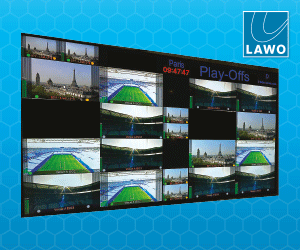With the fall of the Gaddafi regime last month, BroadcastPro ME had the exclusive opportunity to explore one media groups entry into Libya and the launch of its multi-million dollar radio service in the country. As the first wave of discontent and signs of a revolution hit Libya last year, there was a prescient that […]
 With the fall of the Gaddafi regime last month, BroadcastPro ME had the exclusive opportunity to explore one media groups entry into Libya and the launch of its multi-million dollar radio service in the country.
With the fall of the Gaddafi regime last month, BroadcastPro ME had the exclusive opportunity to explore one media groups entry into Libya and the launch of its multi-million dollar radio service in the country.
As the first wave of discontent and signs of a revolution hit Libya last year, there was a prescient that things would no longer bode well for the Gaddafi regime. For a country, where freedom of speech has been heavily curtailed and the media significantly censored, the impending fall of the ruling regime suddenly made Libya a hotbed for broadcasters always on the hunt for virgin territory. Sure enough, even as the regime stumbled, new radio stations came to life, one by one.
Dubai-based Al Aan TV was one of the first to seize the opportunity and establish four radio transmission sites in the key cities of Libya including Benghazi, Tripoli, Misrata and Nalut with two more slated to go on air before the end of 2011 in Sabha and Shahhat. Al Aan TV has a significant advantage. The infotainment channel carries a mix of general entertainment and news that is primarily targeted at women and already enjoys popularity with viewers in Libya. In addition, Al Aan TV has journalists across Libya covering news exclusively for its TV channel. The TV stations technical project manager Mohammed Irfan Gondal was tasked with seeing the project through from start to finish.
“Our main objective is to operate radio and TV stations with local content in Libya once the political situation stabilises. But we wanted to get a foothold in the country quickly so we decided to establish our own transmitter sites in East Libya first and begin by transmitting Al Aan TVs content both for radio and TV. Where the programming does not suit the medium, we replace it with other audio programmes or music,” explains Irfan.
The first point of action, however, was to establish a TV transmitter site as well as an FM transmitter site in Benghazi. And so, the journey began for Irfan, who made his first trip to Libya in June with several subsequent trips to establish contact with local players, secure FM frequencies for the stations radio channels from the National Transitional Council (NTC), dodge shady characters and work out the logistics of bringing equipment into the country. “We looked at several different options in terms of solutions and routes through which to potentially bring those systems into Libya.

Eventually, we decided to engage with manufacturers from Italy due to the close working history between the two countries and the expertise manufacturers had in working with the Libyan people. Given the tight project deadline, budget and other factors, we believed that Italy provided the best solutions and services, explains Irfan.
Two main manufacturers, namely DB Elettronica and Elenos were identified to supply the transmitters. “Both companies are well known for their radio solutions,” explains Irfan. “In addition, Elenos distributor and systems integrator in Dubai, Broadcast Media Zone (BMZ), has designed and integrated several state-of-the-art radio stations in Pakistan. We felt it would be ideal to work with someone like that.” Unlike most radio stations, however, Al Aan had a special requirement. As it was downlinking its signals from satellite and relaying it on radio in Libya, it required additional features to be incorporated into its transmission system.
As a result, it was essential that the transmitters needed to be customised to the companys specific requirements. A 5.5 KW transmitter with additional features such as an integrated receiver decoder (IRD), monitoring equipment and FM tuner was pre-assembled in Italy by DB-Elettronica for Al Aans Benghazi site and shipped to Libya. This professional IRD was essential to downlink Al Aans signal from the satellite and relay it on FM as radio. In Tripoli, the facility includes a downlink antenna. In addition, a transmission server with a playout server has been fitted that can be controlled from Al Aan in Dubai to switch programmes that are not suitable for the medium. In Tripoli, Nalut, and the new sites, Sabha and Shahhat, Al Aan opted for similar functionality but smaller Elenos transmitters that were assembled by BMZ.
For Imran Azfar, the GM of BMZ and a radio specialist, the task ahead was daunting. “The challenge was to design and integrate a plug-and-play FM broadcast station in a box. This was not an off-the-shelf requirement. We designed a solution that had the ability to backhaul Al Aan TVs audio to five terrestrial mobile FM stations in Libya and also enable local content contribution, live phone calls, local and remote signal monitoring as well as broadcast processing. In addition, we had to ensure that we could remotely control the transmission power, swap the frequencies, enable time-based switching on and powering off features. All this was packed in a compact plug-and-play unit. On the end users side, no technical skills were required to operate such a system,” explains Azfar.
These compact studio mobile kits have now been fitted into Al Aans facilities in Benghazi, Tripoli and Nalut. Similar studio kits will also be fitted in Sabha and Shahhat. Irfan explains: “These studio mobile kits have not been done before so they needed to be customised for us. Unfortunately, it was difficult to take all of the equipment to Dubai, assemble it there and ship the assembled solution to Libya. So the systems integrator flew to Italy, where some of the assembly was done. The rest was done in Libya”.
For Misrata, however, which covers a much larger geographical area, Al Aan opted for a 9KW out-of-the-box transmitter from Turkish manufacturer On-Air. One of the biggest challenges was the logistics of shipping equipment to Libya, explains Irfan. “We tried to gain access from Malta and Crete (Greece) but were unsuccessful. The shipment of our transmitter was delayed twice from Italy because of the war situation. We were eventually successful in getting our broadcast equipment in from other neighboring countries such as Egypt and Tunis. We travelled with our SNG from Cairo to Benghazi and also looked at how to take our production equipment through Tunisia,” adds Irfan.
While the systems were being shipped, Irfan and his local team rented out transmission towers in most areas and installed antenna systems to enable broadcast. In Benghazi, however, the team built its own mast measuring 9m for UHF transmission and 9m for FM transmission. “We studied the local market very closely and this helped in the installation of our FM and UHF systems in Benghazi. The masts were produced locally and that saved us time, cost, shipping and labour. The power installation material was also purchased and installed locally,” adds Irfan.
For the technical project manager who has worked for several years in TV, radio offered a new opportunity to test his skill and learn about new areas in broadcast. “This is the first time I launched radio but having done everything from scratch, it was a fantastic learning experience.”
The team also scouted the market for local talent to ensure that costs were kept down, adds Irfan. “This move helped us cut our costs substantially and build our own team rather than sourcing cameramen and FM/UHF engineers from outside. We now have well trained teams running our transmission operations smoothly from all four cities.” Al Aans Tripoli site boasts a full-fledged studio facility to run a turnkey radio station. By the end of the year, Benghazi will also have a similar facility. Presently, however, all sites have well established transmission facilities. Although most of these sites use the same radio frequency 105.3Mhz , Al Aan needed to establish various transmission sites across Libya owing to the vastness of the landscape and the lack of media infrastructure to support broadcast. “Libya is about one-and-a-half times bigger than Egypt in terms of land but has only six million people unlike Egypt, which has a population of roughly 85 million. The land is vast and people are spread across so we needed to have this kind of an infrastructure,” he justifies.
On August 1, Al Aan launched its services in Benghazi on both UHF and radio in time for Ramadan. On September 1, Tripoli and Misrata went live and subsequently, Nalut went live. Presently, each facility is run with the help of three people including a technical assistant, an engineer and someone who looks after the playlists and media. Al Aan has a strong foothold in Libya but its not the only one. Even as this magazine goes to press, we have news that at least four other radio stations have launched in the country and several international media organisations are mulling more services in Libya.
















































































